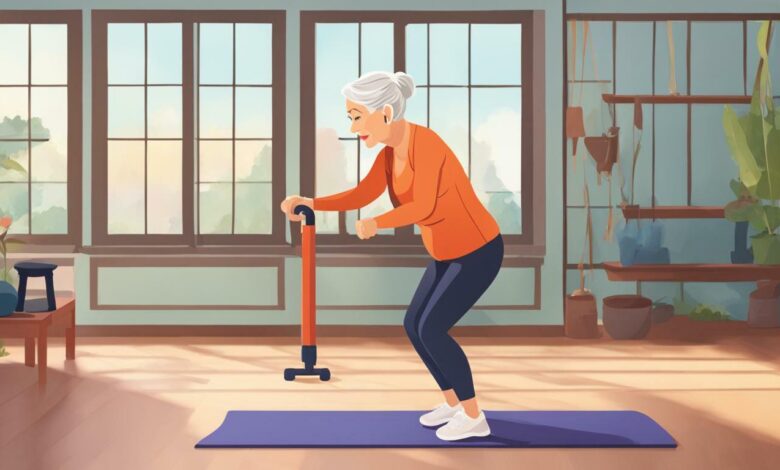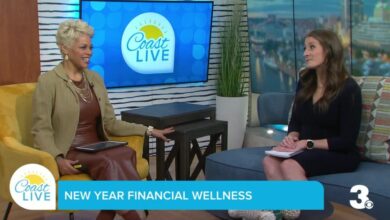Stay Active and Fit: Low-Impact Exercises for Seniors

As you age, it’s important to prioritize your physical health and stay active. Engaging in regular exercise can help maintain your mobility, strength, and balance, allowing you to lead a more independent and fulfilling life. Low-impact exercises are an excellent option for seniors, as they challenge your body’s limits without putting undue stress on your joints and muscles.
In this section, we’ll explore the benefits of low-impact exercises for seniors, and provide guidance on selecting exercises that are safe and effective for your needs.
Key Takeaways:
- Regular exercise is crucial for maintaining physical health as you age.
- Low-impact exercises can challenge your body without causing harm to your joints and muscles.
- It’s important to select exercises that are safe and effective for your individual needs.
- By staying active, you can maintain your independence and lead a more fulfilling life.
- Consult with a healthcare professional before starting a new exercise program to ensure it’s safe and appropriate for your condition.
The Benefits of Staying Active as a Senior
As you age, staying active becomes increasingly important for maintaining good health and overall well-being. Regular exercise can help prevent chronic illnesses such as diabetes, heart disease, and osteoporosis. It is also a great way to maintain muscle mass, improve balance and flexibility, and boost mood and cognitive function.
Physical activity can help strengthen your bones, reduce the risk of falls, and improve cardiovascular health. Studies have shown that seniors who engage in regular exercise have a reduced risk of developing age-related cognitive decline and dementia. Exercise also helps to boost energy levels and improve sleep quality.
Aside from the physical benefits, staying active can also help seniors maintain social connections and prevent feelings of isolation and loneliness. Joining group fitness classes, walking groups, or sports teams can help seniors stay engaged with others and combat feelings of social isolation.
To sum up, staying active as a senior is essential for maintaining good health, both physically and mentally. Engaging in regular exercise can not only help prevent chronic diseases, but also improve cognitive function, mental health, and social connections.
Therefore, it is crucial to prioritize physical activity in your daily routine to ensure that you stay healthy and active in your senior years.
Exploring Low-Impact Exercises for Seniors
As a senior, it is essential to engage in exercises that improve mobility, strength, and balance, without putting excessive strain on your joints and muscles. Low-impact exercises are a great way to challenge your body’s limits while minimizing the risk of injury. Here are some low-impact exercises suitable for seniors:
| Exercise | Description |
|---|---|
| Walking | Walking is a low-impact exercise that improves cardiovascular health and promotes joint flexibility. It is recommended to start with short walks and gradually increase the distance over time. |
| Water Aerobics | Water aerobics is a low-impact exercise that provides resistance while reducing the impact on joints. This exercise is suitable for seniors with arthritis or joint pain. |
| Cycling | Cycling is a low-impact exercise that improves cardiovascular health, lower body strength, and joint flexibility. It is recommended to use a stationary bike to minimize the risk of falls or accidents. |
| Strength Training | Strength training with light weights or resistance bands can help improve muscle tone, enhance bone density, and reduce the risk of falls. It is recommended to start with basic movements and gradually increase the number of repetitions. |
| Yoga | Yoga is a low-impact exercise that improves flexibility, balance, and coordination. It is recommended to attend a beginner’s class and inform the instructor of any health conditions or limitations. |
Remember to always listen to your body and avoid exercises that cause pain or discomfort. It is also essential to incorporate stretching exercises to improve flexibility and reduce the risk of injury.
Creating a Safe and Effective Exercise Routine
As a senior, it is essential to create an exercise routine that is safe and effective for your body. By following these tips, you can ensure that your exercise program supports your overall health and well-being.
Warm Up
Before you start any exercise routine, it’s important to warm up your body. A proper warm-up helps to increase blood flow, loosen up muscles, and prevent injury. Start with low-intensity activities such as walking or stretching for 5-10 minutes before moving on to more strenuous exercises.
Set Realistic Goals
Setting realistic exercise goals is vital to keeping you motivated and engaged in your routine. Determine what works best for you, and what your body can handle, before creating your exercise plan. Start with smaller goals and gradually increase the difficulty level of your exercises as you progress.
Incorporate Resistance Training
Incorporating resistance training into your exercise routine has numerous benefits. It helps to build muscle and increase bone density, which are important for maintaining overall health. Resistance training can be done with resistance bands, weights, or body-weight exercises. Start with a low number of repetitions and gradually increase as you build strength.
Include Flexibility Exercises
Stretching and other flexibility exercises are essential for maintaining mobility as you age. They help to improve range of motion and flexibility, prevent injury, and reduce muscle soreness. Include a variety of stretches in your routine, focusing on different muscle groups.
Gradually Increase Intensity
It’s important to gradually increase the intensity of your exercise routine to avoid injury and overexertion. Start with low-intensity exercises and gradually increase the duration and intensity as your body becomes accustomed to the routine.
Consult with a Healthcare Professional
Before starting any exercise program, it’s essential to consult with a healthcare professional. They can assess your fitness level, identify any underlying health conditions, and provide you with personalized recommendations to ensure that your exercise routine is safe and effective.
By incorporating these tips into your exercise routine, you can create a safe and effective program that meets your individual needs as a senior. Remember, it’s never too late to start exercising, and the benefits are well worth the effort!
Consulting with a Healthcare Professional
Before embarking on any new exercise program, it is essential that you consult with a healthcare professional, especially as a senior. This step is crucial to ensure that you are not putting yourself at risk of injury or exacerbating any underlying health conditions.
When you visit your doctor or healthcare provider, they will assess your fitness level and discuss any pre-existing health conditions that may affect your ability to exercise safely. They may also recommend specific exercises or modifications to your existing routine to help you achieve your fitness goals while keeping you safe.
Stress the significance of consulting with a healthcare professional before starting a new exercise program. They can help you develop a personalized exercise plan that takes into account your unique health profile, fitness level, and lifestyle. Please note that this step is particularly important if you have any chronic medical conditions, such as diabetes, heart disease, or arthritis.
Remember, the advice and guidance of a healthcare professional can help you avoid injury and ensure that your exercise routine is both safe and effective.
Sample Low-Impact Exercise Routine for Seniors
Now that you have an understanding of the benefits of low-impact exercises and how to create a safe and effective exercise routine, let’s put it all into practice with a sample low-impact exercise routine.
| Exercise | Repetitions | Sets |
|---|---|---|
| Marching in place | 20 | 2-3 |
| Wall push-ups | 10-15 | 2-3 |
| Seated leg raises | 10-15 per leg | 2-3 |
| Standing side leg lifts | 10-15 per leg | 2-3 |
| Seated shoulder presses with resistance bands | 10-15 | 2-3 |
| Seated back extensions | 10-15 | 2-3 |
| Seated marches with resistance bands | 20 | 2-3 |
| Seated bicycle crunches | 10-15 per leg | 2-3 |
Remember to warm up before starting this routine with marching in place for a few minutes. Start with one set of each exercise and gradually increase to two or three sets as you become more comfortable.
As you progress, feel free to challenge your body’s limits by increasing the number of repetitions or sets, or by incorporating other low-impact exercises into your routine.
Remember to consult with healthcare professionals if you have any concerns or questions about your exercise routine. With consistency and dedication, you can maintain mobility, strength, and balance well into your senior years.
Conclusion
In conclusion, staying active and fit as a senior is crucial for maintaining a healthy and fulfilling lifestyle. Low-impact exercises are an excellent way to challenge your body’s limits, improve mobility, strength, and balance, and promote overall well-being. Regular exercise can also boost cardiovascular health, maintain muscle tone, enhance cognitive function, and elevate mood.
To create a safe and effective exercise routine, it’s important to warm up properly, set realistic goals, and gradually increase intensity over time. Resistance training and flexibility exercises can also be incorporated to further enhance physical fitness. However, before embarking on any new exercise program, it’s essential to consult with a healthcare professional to assess individual fitness levels and address any underlying health conditions.
We hope that this article has provided valuable insights into the benefits of low-impact exercises for seniors. By incorporating these exercises into your routine, you can improve your physical fitness, maintain your independence, and enjoy an active and fulfilling life. So why wait? Start your fitness journey today and prioritize your well-being for years to come!
FAQ
Q: Why is it important for seniors to stay active?
A: Staying active as a senior has numerous benefits, including maintaining mobility, strength, and balance, improving cardiovascular health, boosting mood, and enhancing cognitive function.
Q: What are low-impact exercises?
A: Low-impact exercises are gentle on the joints and muscles, making them suitable for seniors. These exercises help improve mobility, increase strength, and enhance balance without putting excessive strain on the body.
Q: How can seniors create a safe and effective exercise routine?
A: Seniors can create a safe and effective exercise routine by warming up before exercising, setting realistic goals, gradually increasing intensity, incorporating resistance training and flexibility exercises, and consulting with a healthcare professional.
Q: Why is it important to consult with a healthcare professional before starting a new exercise program?
A: Consulting with a healthcare professional before starting a new exercise program ensures that individual fitness levels are assessed, any underlying health conditions are addressed, and personalized recommendations are provided to ensure safe and effective exercise.
Q: Can you provide a sample low-impact exercise routine for seniors?
A: Yes, we have provided a sample low-impact exercise routine for seniors. It includes a variety of exercises targeting different muscle groups along with step-by-step instructions.




